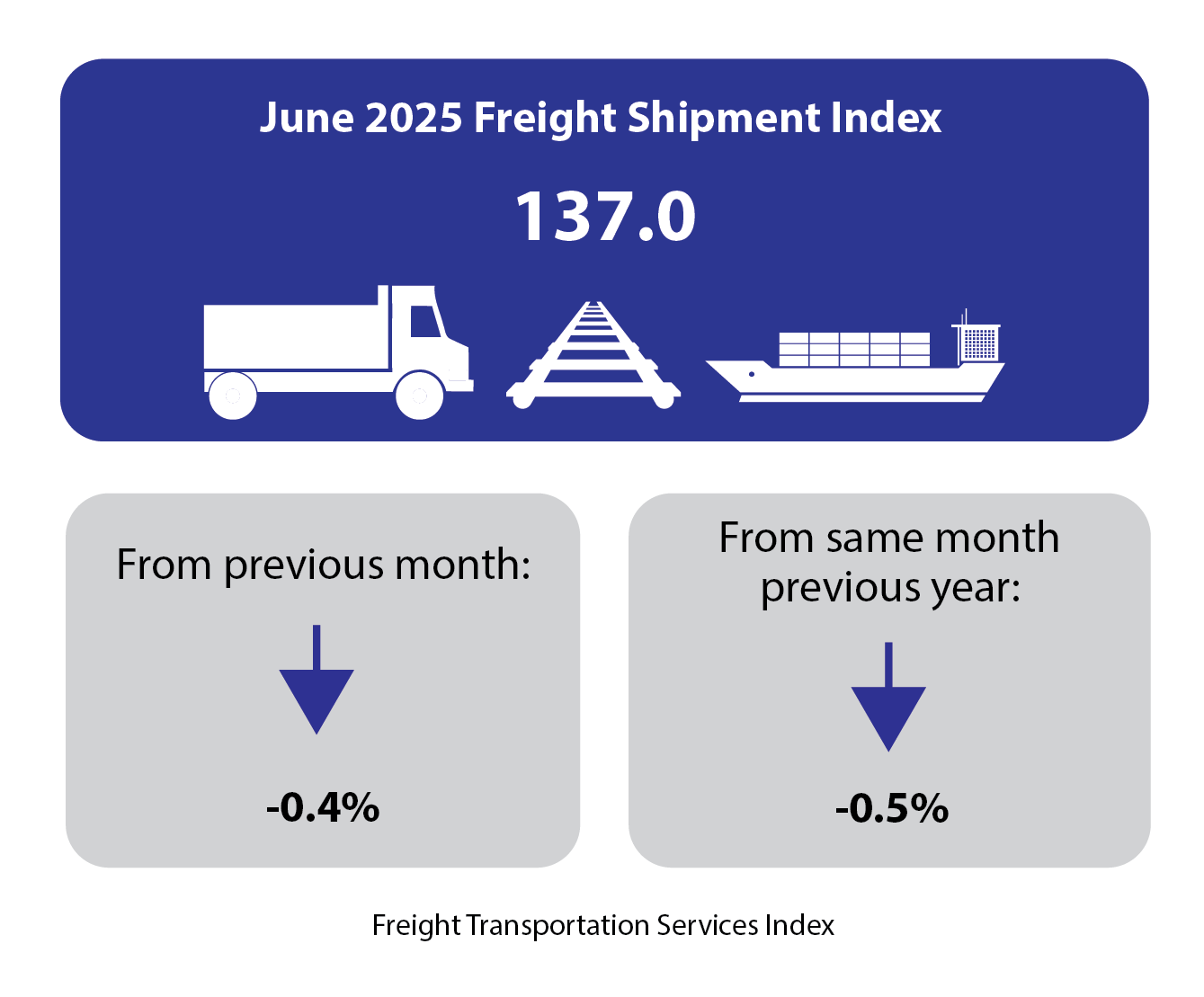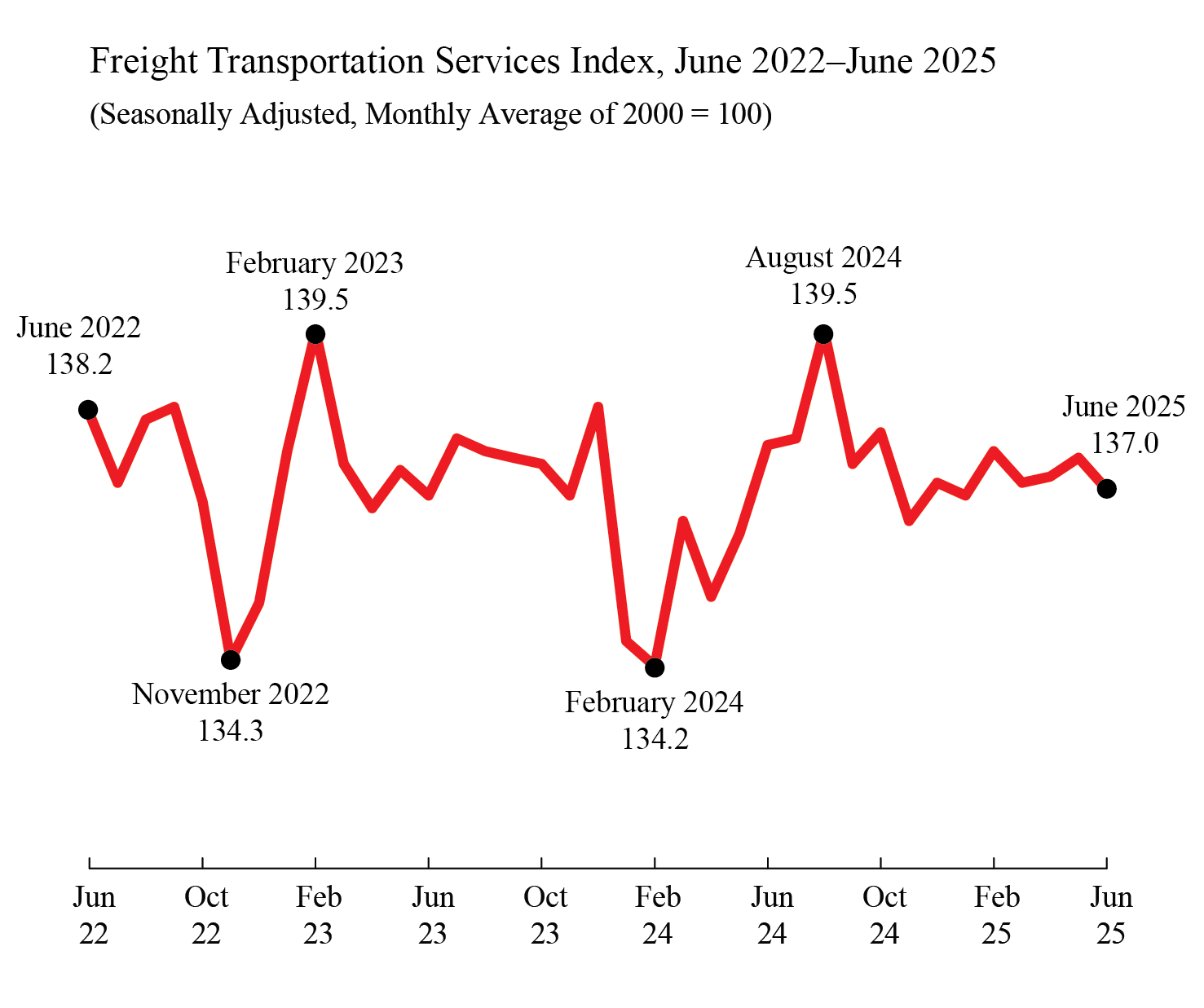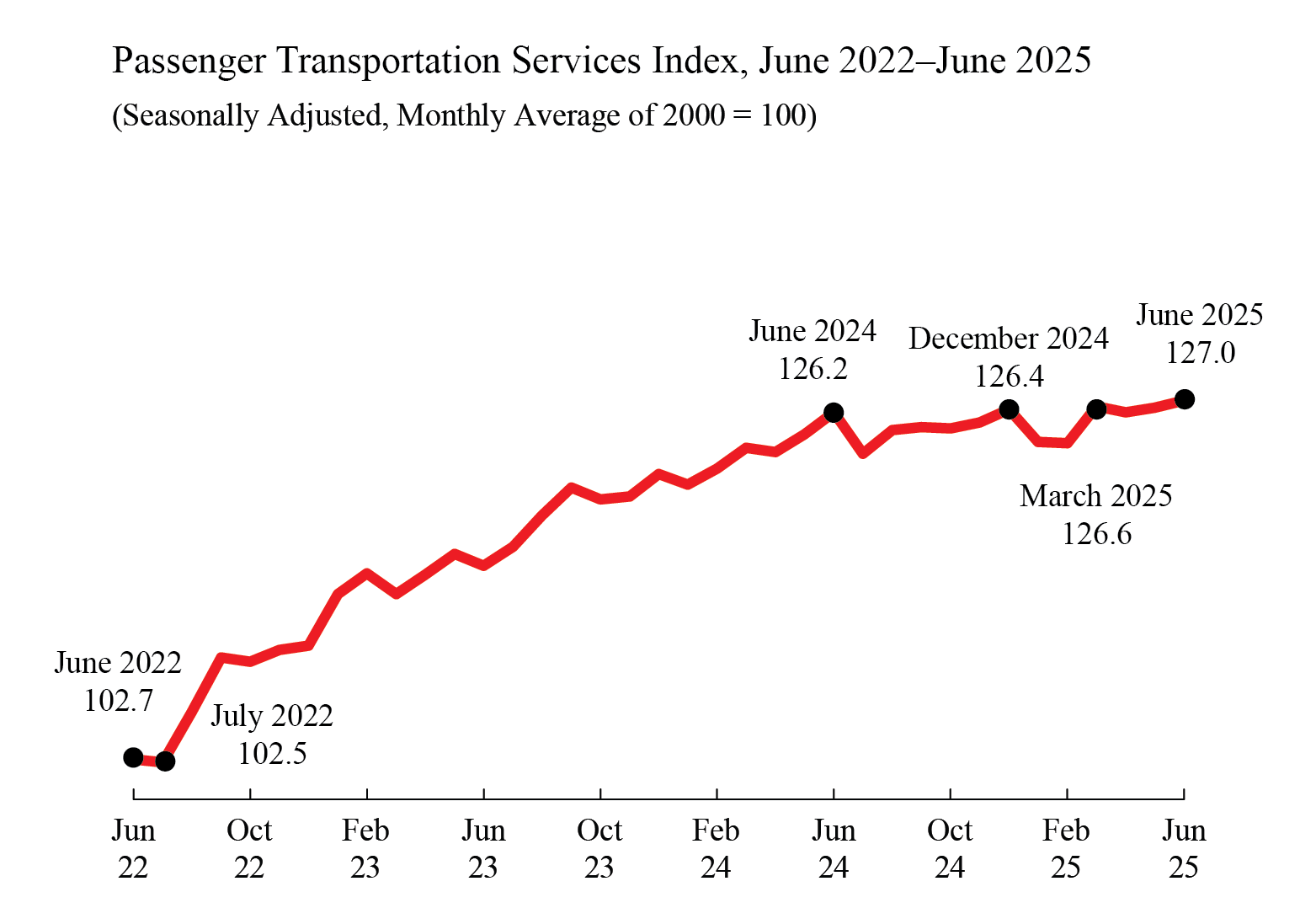The June 2025 Freight Transportation Services Index (TSI) Fell 0.4% from the Previous Month and Fell 0.5% from the Same Month Last Year
BTS 50-25
This release is published on a fixed schedule as required by the Office of Management and Budget, and statistics in this release may be revised when inputs to the statistics are corrected or updated. Data on the program page of this website are the most up-to-date and complete.

The Freight Transportation Services Index (TSI), fell 0.4% in June from May, falling for the first month after two consecutive months of growth, according to the U.S. Department of Transportation Bureau of Transportation Statistics (BTS). From June 2024 to June 2025 the freight index fell 0.5%. The freight TSI measures the amount of freight carried by the for-hire transportation industry.

Freight transportation Services Index in June 2022 through June 2025
| Month | Freight TSI |
|---|---|
| Jun-22 | 138.2 |
| Jul-22 | 137.1 |
| Aug-22 | 138.1 |
| Sep-22 | 138.3 |
| Oct-22 | 136.8 |
| Nov-22 | 134.3 |
| Dec-22 | 135.2 |
| Jan-23 | 137.6 |
| Feb-23 | 139.5 |
| Mar-23 | 137.4 |
| Apr-23 | 136.7 |
| May-23 | 137.3 |
| Jun-23 | 136.9 |
| Jul-23 | 137.8 |
| Aug-23 | 137.6 |
| Sep-23 | 137.5 |
| Oct-23 | 137.4 |
| Nov-23 | 136.9 |
| Dec-23 | 138.3 |
| Jan-24 | 134.6 |
| Feb-24 | 134.2 |
| Mar-24 | 136.5 |
| Apr-24 | 135.3 |
| May-24 | 136.3 |
| Jun-24 | 137.7 |
| Jul-24 | 137.8 |
| Aug-24 | 139.5 |
| Sep-24 | 137.4 |
| Oct-24 | 137.9 |
| Nov-24 | 136.5 |
| Dec-24 | 137.1 |
| Jan-25 | 136.9 |
| Feb-25 | 137.6 |
| Mar-25 | 137.1 |
| Apr-25 | 137.2 |
| May-25 | 137.5 |
| Jun-25 | 137.0 |
Bureau of Transportation Statistics
The Passenger TSI rose 0.4% in June from May, rising for the second consecutive month. From June 2024 to June 2025 the passenger index rose 0.6%. The passenger TSI measures passenger transportation volumes on local transit, intercity rail, and air transportation. The Combined Freight and Passenger Index fell by 0.2% in June from May and fell by 0.2% from June 2024 to June 2025.

Analysis: The Freight TSI decreased in June due to seasonally adjusted decreases in rail intermodal, rail carloads, and trucking; air freight and water increased; and pipeline remained unchanged.
The June decrease occurred in the context of positive results in other indicators. The Federal Reserve Board Industrial Production Index was up 0.3% in June, reflecting increases of 0.1% in manufacturing and 2.8% in utilities, while mining was down 0.3%. Housing starts were up 4.6%. Personal Income increased by 0.3%.
The Institute for Supply Management Manufacturing Index in June increased 0.5 to 49, and although the number increased, it still indicates a contraction. A reading above 50 indicates an expansion of U.S. manufacturing, while a reading below 50 indicates a contraction.
The passenger index increased in June due to increases in air passenger miles, rail passenger miles, and transit ridership. The June increase in the Passenger TSI brought it to a new high for 2025 but 7.3% below the all-time high in January 2020.
BTS returned to publishing the passenger and combined index for the same month as the freight index. BTS began publishing the passenger and combined indexes only through the latest month of data available for air passenger travel when BTS released data for January 2020 - the first month where COVID-19 affected passenger travel. Historically, BTS forecasted one month of passenger air travel for the passenger index. The COVID-19 pandemic disrupted regular seasonal patterns in air travel and made it difficult to estimate air travel. Regular seasonal patterns in air travel re-emerged, enabling BTS to accurately estimate passenger air travel again.
BTS estimates air freight and air passenger one month ahead of reported data (i.e., the air data are available through April, BTS estimates the May air passenger and freight in the May index).
Revisions: Monthly data has changed from previous releases due to the use of concurrent seasonal analysis, which results in seasonal analysis factors changing as each month’s data are added. BTS revised the May freight index to 137.5 from 137.0 in last month's release, and the May passenger index remained unchanged from 126.5.
BTS scheduled the release of the July 2025 index for September 10, 2025.
See Seasonally-Adjusted Transportation Data for historical data from 2000 to the present and numbers for individual modes. The TSI and modal data also can be found on the FRED database. See Transportation as an Economic Indicator: Transportation Services Index for charts and discussion about the TSI and its relationship to the economy. The BTS report, Transportation Services Index and the Economy, provides a detailed explanation about the relationship between the TSI and economic cycles.
Looking for tables? BTS moved all tables online to streamline the monthly release.
Brief Explanation of the TSI
The TSI measures the month-to-month changes in the output of services provided by the for-hire transportation industries. The freight index measure changes in freight shipments while the passenger index measures changes in passenger travel.
The TSI tells us how the output of transportation services increased or decreased from month to month. The index can be examined together with other economic indicators to produce a better understanding of the current and future course of the economy. The movement of the index over time can be compared with other economic measures to understand the relationship of changes in transportation output to changes in Gross Domestic Product.
The freight transportation index consists of:
- For-hire trucking,
- Railroad freight services (including rail based intermodal shipments such as containers on flat cars),
- Inland waterways transportation,
- Pipeline transportation (including principally petroleum and petroleum products and natural gas), and
- Air freight.
The index does not include international or coastal waterborne movements, private trucking, courier services, or the US Postal Service.
The passenger transportation index consists of:
- Local transit,
- Intercity passenger rail, and
- Passenger air transportation.
The index does not include intercity bus, sightseeing services, ferry services, taxi service, private automobile usage, or bicycling and other non-motorized transportation.
The TSI includes only domestic "for-hire" freight and passenger transportation. For-hire transportation consists of freight or passenger transport services provided by a firm to external customers for a fee. The TSI does not include taxi services, paid ride services in personal motor vehicles (e.g., Uber, Lyft, etc.), intercity bus services, in-house transportation (vehicles owned and operated by private firms for their own use), or noncommercial passenger travel (e.g., trips in the household car).
To receive updates from BTS directly to your email, please consider subscribing to our GovDelivery service.
